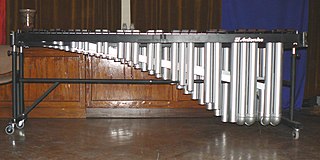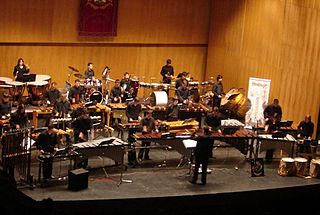
The marimba is a percussion instrument consisting of a set of wooden bars struck with yarn or rubber mallets to produce musical tones. Resonators or pipes suspended underneath the bars amplify their sound. The bars of a chromatic marimba are arranged like the keys of a piano, with the groups of two and three accidentals raised vertically, overlapping the natural bars to aid the performer both visually and physically. This instrument is a type of idiophone, but with a more resonant and lower-pitched tessitura than the xylophone. A person who plays the marimba is called a marimbist or a marimba player.

The James Gang was an American rock band formed in Kent, Ohio in 1966. The band went through a variety of line-up changes until they recorded their first album as a power trio consisting of Joe Walsh, Tom Kriss (bass) and Jim Fox (drums). Dale Peters replaced Kriss on bass for the band's second and third albums. The band had two hit songs, "Funk #49" and "Walk Away", which continue to be popular on classic rock and AOR stations. In 1972, Walsh left to pursue a solo career and would later join the Eagles. The band continued on with a variety of other guitarists and lead singers to replace Walsh, but failed to produce a hit song over the course of six more studio albums and broke up in 1977. Various incarnations have reformed for several reunions since then.

A percussion ensemble is a musical ensemble consisting of only percussion instruments. Although the term can be used to describe any such group, it commonly refers to groups of classically trained percussionists performing primarily classical music. In America, percussion ensembles are most commonly found at conservatories, though some professional groups, such as Nexus and So Percussion exist. Drumlines and groups who regularly meet for drum circles are two other forms of the percussion ensemble.
Lawrence "Jack" Imel was an American musician, dancer, singer, and television producer who is best known for his work on The Lawrence Welk Show.

Rain Tree Crow is the sole album released by English band Rain Tree Crow, a reunion project by the members of the new wave band Japan. Recorded in 1989 and 1990 and released in April 1991, it was the first time that members David Sylvian, Mick Karn, Steve Jansen and Richard Barbieri had collaborated as a four-piece since 1982.
Tom Collier is a multi-instrumental percussionist and vibraphonist, with a career in music spanning more than fifty years. He has performed and recorded as a session musician with many important jazz, classical, and popular artists. He has also performed and recorded with his own jazz group and has released solo albums. He joined the faculty at the University of Washington in 1980.
Orchestral percussion are percussion instruments used in orchestras and concert bands mainly in classical music and related styles. The term can also refer to the department or study of performance on said instruments at a music school or conservatory. Generally within such a department, students are required to study all aspects of orchestral playing; with marimba, snare drum, and timpani being the three most basic areas of study. Orchestral percussion usually does not include a drum set, but some compositions do require one.
Mitchell Thomas Peters was a principal timpanist and percussionist with the Los Angeles Philharmonic Orchestra. He composed well-known pieces for the marimba such as "Yellow After the Rain" and "Sea Refractions"; it is said that these works were composed because Peters felt that there was a lack of musically interesting material that would introduce his students to four-mallet marimba techniques.
Vida Chenoweth was the first professional solo classical marimbist, an ethnomusicologist and a linguist.

Michael Blake is a South African contemporary classical music composer and performer. He studied in Johannesburg in the 1970s and was associated with conceptual art and the emergence of an indigenous experimental music aesthetic. In 1976 he embarked on 'African Journal', a series of pieces for Western instruments that drew on his studies of traditional African music and aesthetics, which continued to expand during two decades in London until he returned to South Africa in 1998. From around 2000 African music becomes less explicit on the surface of his compositions, but elements of rhythm and repetition remain as part of a more postcolonial engagement with material and form. He works in a range of styles including minimalism and collage, and now also forages for source material from the entire musical canon.
The Baja Marimba Band was a musical group led by marimba player Julius Wechter. Formed by producer Herb Alpert after his own Tijuana Brass, the Baja Marimba Band outlasted the Tijuana Brass by several years in part due to TV producer Chuck Barris, who included the group's music on his game shows in the 1970s.
David R. Gillingham is an American contemporary composer, who is known for his works for concert band and percussion ensemble.
David C. Sampson is an American contemporary classical composer.

Drumming is a piece by minimalist composer Steve Reich, dating from 1970–1971. Reich began composition of the work after a short visit to Ghana and observing music and musical ensembles there, especially under the Anlo Ewe master drummer Gideon Alorwoyie. His visit was cut short after contracting malaria. K. Robert Schwarz describes the work as "minimalism's first masterpiece."
Milton "Milt" Holland was an American drummer, percussionist, ethnomusicologist, and writer in the Los Angeles music scene. He pioneered the use of African, South American, and Indian percussion styles in jazz, pop and film music, traveling extensively in those regions to collect instruments and learn styles of playing them.
Makoto Shinohara is a Japanese composer.
Robert Paterson is an American composer of contemporary classical music, as well as a conductor and percussionist. His catalog includes over 100 compositions. He has been called a "modern day master" and is primarily known for his colorful orchestral works, large body of chamber music and clear vocal writing in his operas, choral works, vocal chamber works and song cycles.
Gary Kulesha is a Canadian composer, pianist, conductor, and educator. Since 1995, he has been Composer Advisor to the Toronto Symphony Orchestra. He has been Composer-in-Residence with the Kitchener-Waterloo Symphony (1988–1992) and the Canadian Opera Company (1993–1995). He was awarded the National Arts Centre Orchestra Composer Award in 2002. He currently teaches on the music faculty at the University of Toronto.
Andy Akiho is an American musician and composer of contemporary classical music. A virtuoso percussionist based in New York City, his primary performance instrument is steel pans. He took interest in becoming a percussionist when his older sister introduced him to a drum set at the age of 9. Akiho first tried his hand at the steel pan when he became an undergraduate at the University of South Carolina. He began taking several trips to Trinidad after college to learn and play music. From there, he started writing pieces of his own.





